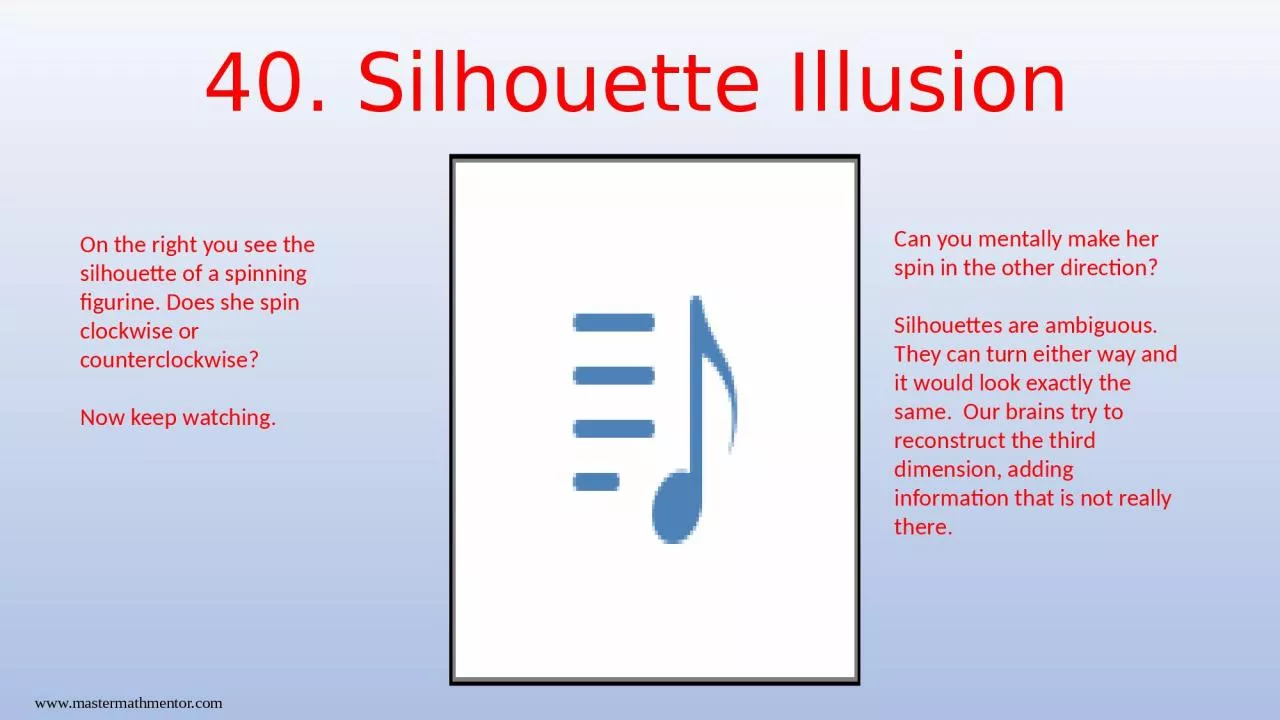

On the right you see the silhouette of a spinning figurine Does she spin clockwise or counterclockwise Now keep watching Can you mentally make her spin in the other direction Silhouettes are ambiguous They can turn either way and it would look exactly the same Our brains try to reconstruc ID: 934461
Download Presentation The PPT/PDF document "40. Silhouette Illusion www.mastermathme..." is the property of its rightful owner. Permission is granted to download and print the materials on this web site for personal, non-commercial use only, and to display it on your personal computer provided you do not modify the materials and that you retain all copyright notices contained in the materials. By downloading content from our website, you accept the terms of this agreement.
Slide1
40. Silhouette Illusion
www.mastermathmentor.com
On the right you see the silhouette of a spinning figurine. Does she spin clockwise or counterclockwise?
Now keep watching.
Can you mentally make her spin in the other direction?
Silhouettes are ambiguous. They can turn either way and it would look exactly the same. Our brains try to reconstruct the third dimension, adding information that is not really there.
Slide241. Schroeder Stairs Illusion
The drawing can be described as an “ambiguous figure” in that it may be perceived as two (or more) different objects. It is also “reversible” in that after some time of staring at the figure the perception of its orientation becomes involuntarily reversed. It is also “
bistable” in that there are two (rather than one) stable perceptions of the drawing. Usually, the involuntary switch of perception occurs with approximate frequency of once in 7.5-12.5 seconds. The change of perception may be attributed either to brain fatigue or to conscious selection.
Schroeder stairs (named after German scientist Heinrich G. F. Schröder, 1858) is an optical illusion which may be perceived either as a drawing of a staircase leading from left to right downwards or the same staircase only turned upside down.
Is the front of the stairs red or yellow?
The artist M.C. Escher used Schroeder stairs in two of his works, ”Relativity” and “Concave and Convex.”
www.mastermathmentor.com
Slide342. Checker-Shadow Illusion
www.mastermathmentor.com
In the 3-dimensional picture below, a green cylinder stands on a checkered plane with light coming from the top left.
Which square is brighter, A or B?
You may be surprised to find that they
have exactly the same brightness
.
Our visual system immediately estimates lighting and uses this to judge the property of the material, regardless of shadow. When asked “which is brighter”, you were actually (and sensibly) judging the material: Is it a light or dark square in the checkerboard, whatever the lighting? Ted Adelson discovered this illusion in 1995.
The checker-shadow illusion is an offshoot of the illusion described by Tom
Cornsweet
in 1969. The region to the right of the “edge” in the middle looks lighter than that on the left.
But with the region containing the edge blackened out, you can see that the left and right have the same brightness
While it looks like the top square is darker than the bottom one, they are the same except at the edges.
The middle area, where these edges meet, causes the illusion. When covered up you can see the two upper and lower sections are the same color.
Slide443. Tilted Table Illusion
www.mastermathmentor.com
Most people would agree that the top table is tilted to the left. And yet, if we remove the cross-hatching…
Most people would agree that the top table balances. And yet, if we remove the cross-hatching…
The table-top illusion is a case of the
Zollner
illusion (German
astrophyscist
, 1860). The long lines with cross hatches don’t appear parallel but in fact they are.
Slide544. After 6 Beers Illusion
www.mastermathmentor.com
You see a princess in the picture. When does your perception change? Click.
Can you see both images at the same time?
Slide645. Thatcher Illusion
www.mastermathmentor.com
To the right are two pictures of the late Prime Minister of Great Britain Margaret Thatcher, shown upside down. You probably will agree that although the pictures are not the same, they are similar.
Click.
To determine facial expressions, it is best to see the face in the orientation it is usually seen, … upright.
Slide7Sources
www.mastermathmentor.com
40. Silhouette -
https://michaelbach.de/ot/sze-silhouette/index.html41. Schroeder Stairs - https://www.illusionsindex.org/i/schroeder-stairs, 42. Checker Shadow - https://michaelbach.de/ot/lum-adelsonCheckShadow/ 43. Tilted Table - https://www.illusionsindex.org/ir/zoellner-illusion
,
https://michaelbach.de/ot/ang-tiltedTable/index.html
44. After 6 Beers -
https://www.moillusions.com/before-and-after-six-beers/
https://michaelbach.de/ot/cog-rotations/index.html45. Thatcher - https://michaelbach.de/ot/fcs-thompsonThatcher/index.html